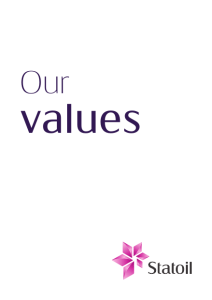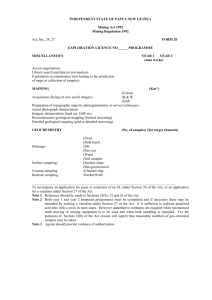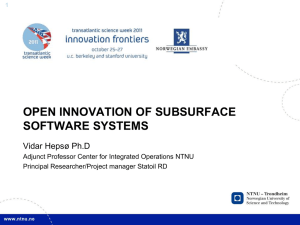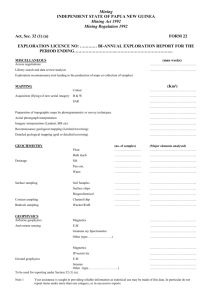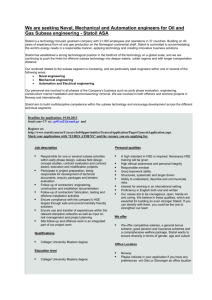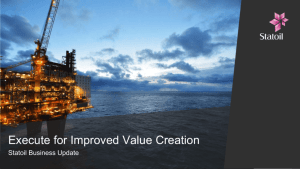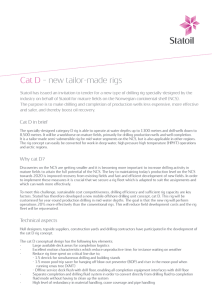Integrated Environmental Monitoring-science week
advertisement
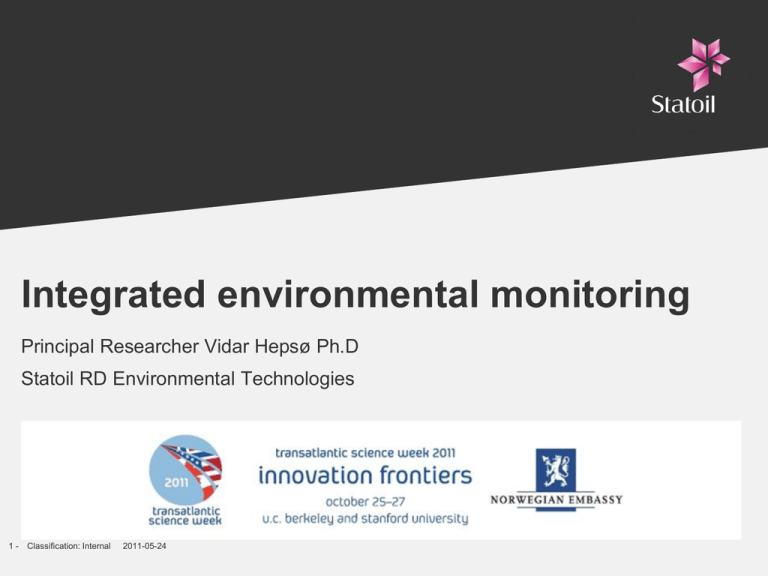
Integrated environmental monitoring Principal Researcher Vidar Hepsø Ph.D Statoil RD Environmental Technologies 1 - Classification: Internal 2011-05-24 Paradigm shift From “expeditionary” offline sampling To continuous environmental monitoring Gain licence to operate by demonstrating prudent operations in sensitive areas 2 - Classification: Internal 2011-05-24 Integrated Environmental Monitoring Asset control room Business Operations Central support functions Emergency response Planning Decision making Workflow Knowledge Sharing & Analytics Learning Analysis Sense making Domain experts Information & work processes External organisations Information & Collaboration Virtual interaction Coordination Shared awareness Intelligent Infrastructure Access Sensors & sensor platforms Connect Sense Background photo: Harald Pettersen 3 - Classification: Internal 2011-05-24 3- Existing sensors & sources Stationary ocean observatory Mobile Scenarios Preparation A Drilling B Seismic & exploration /production drilling. Maybe no permanent infrastructure. No oil & gas activity Off-line. No infrastructure. Background data. C Production Demobilization D E Production. Full real-time IEM in place. Installation. Transition to permanent monitoring system. Shut down/after production. Limited infrastructure. Off-line. 3 infrastructure situations 1. Area with no infrastructure 2. Field with limited power supply and data communication (typically old fields) 3. Field with subsea power supply and fibre optic communication (typically new fields) What do we want to measure? Sensor/Parameter Parameter Data type Location Echo sounder Biological activity (presence of fish, sea mammals and corals etc), gas bubbles, particles in the water columns Echogram, large data files that needs expert interpretation Range Camera with light Visual observation Video and/or still pictures Range Recording Doppler Current Profiler (RDCP) or equivalent Current speed and direction Temperature Conductivity Pressure Oxygen Turbidity (amount of particles in water) Fluorescence Time series, vector data Point source Sediment trap Point data Samples to be analysed in the laboratory Point source Hydrophone Biological activity Echogram, large data files that needs expert interpretation Range Hydrocarbon sniffers Presence of hydrocarbons Point data Point source 5 - Classification: Internal 2011-05-24 Thank you Integrated environmental monitoring Presenters name: Vidar Hepsø Presenters title: Principal Researcher /Project Manager vihe@statoil.com, tel: +47 48034803 www.statoil.com 6 - Classification: Internal 2011-05-24 Current Practice - Monitoring regimes To be carried out by independent 3rd party • Point samples of selected physical/chemical and biological parameters − Sediments − Water column − Soil − Ground water • Remote sensing • Follow-up after spills • Visual surveys 7 - Classification: Internal 2011-05-24 Current Practice - challenges • Flexibility − Monitoring must be suited to the actual habitat − Physical sampling may harm sensitive habitats • Response time of point sampling − Significant time lag between impact occurrence and detection • Cost-effectiveness − Can be improved through integration in design and operations 8 - Classification: Internal 2011-05-24 Morvin, Norway • Located in the Norwegian sea • Area with cold water coral structures • On-line monitoring before, during and after drilling • Physical/chemical data • Visual monitoring • Real time monitoring proved no harm to the coral structure 9 - Classification: Internal Classification: 2011-05-24 2010-10-19 Internal 2011-02-03
